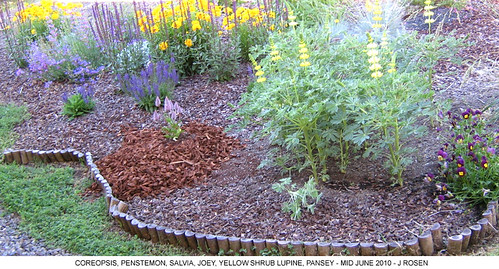Mulch is a topic of many conversations. What types of mulch are applied, when are they applied, why are we using a particular mulch, how often should I apply mulch to my beds, and on and on.
First, I want to thank all of you who donned your snow apparel, cleaned off your cars and headed out for a precarious late morning drive to the nursery. When I walked into the meeting room and saw the smiles on all of your faces, I knew right away, you are ALL die-hard gardeners!! I am thankful for each and every one of you!!
We discussed many types of mulch today and their uses as well as what not to use and why. Consensus shows the Dbl Shred Hardwood Bark Mulch to be the product of choice with most gardeners; its decomposition does not require it to steal nitrogen from the soil or the surrounding plantings. Though, I see Sweet Peat Moss coming in at a very close second. Sweet Peat does not have chemicals or dyes and is very rich in nutrients with a high pH, hence the sweet, so it will not make your soil acidic or burn your plantings like sphagnum peat moss can. Sweet Peat also has a high moisture retention rate, prevents erosion and helps reduce plant stress cause by environmental factors.
If you are looking for something with a higher acid content for your Rhododendrons, Azaleas or other acid loving plants, you might want to use Pine Bark or Pine Chip Mulch; this will help keep your soil pH lower and your acid loving plants happy. We discussed using groundcovers as mulch, as well as learning why you should not use freshly ground wood chips in your ornamental landscape beds, the chips will steal nitrogen from the surrounding area as they break down.
Here are some pointers for your mulch project.
- Make sure the beds are cleaned out before you mulch them, remove weeds, debris and accomplish any early trimming of shrubs.
- Cut a deep edge on the bed if desired before you mulch it
- Choose the right mulch for the application, Dbl Shred hardwood for most all, sweet peat if you want to keep your soil more alkaline and Pine mulch if you want to keep it more acidic. Use freshly ground chips for paths or open areas that do not have plantings.
- Spread evenly 2-3” no more, no less and keep it 2-3” away from trunks or limbs
- Cultivate your mulch 2-3 times per year to promote air flow, water flow and natural decomposition to add organics back into the soil
- LIFT PROPERLY
- And Remember to Always Cultivate Joy in the Garden!!




